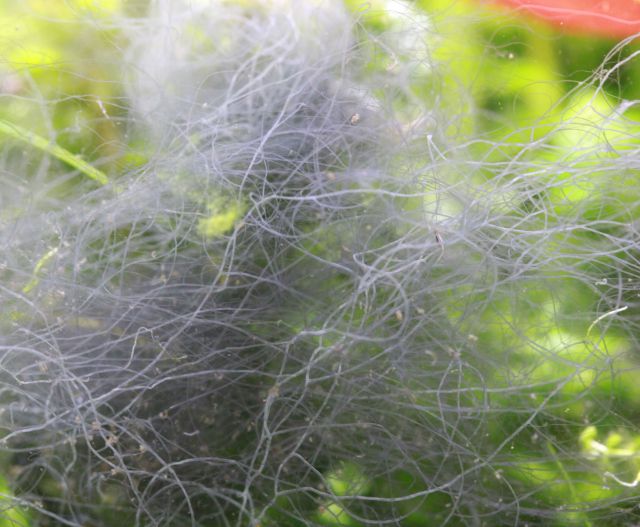In order to get answers to basic questions all around algae in the aquarium, we recommend you read this article first.
Staghorn algae (Compsopogon sp.) belong to the group of red algae. They are easy to diagnose as their growth habit looks a bit like the horns of a stag. They show different shades of grey. If you immerse a piece of these algae in alcohol it will assume a red color. Staghorn algae are usually found on aquarium decoration, technical equipment and the margins of the leaves of aquatic plants. They are hard to remove manually. These algae seem to be quite unattractive for most algae-eating aquarium animals.

Common reasons
In planted tanks that are supplied with liquid fertilisers the appearance of these algae is often an indicator for an overdose of the iron fertiliser. Please adjust the amount you give and reduce it. If you have a water test for iron at hand, check the amount of iron dissolved in the water. Aim for 0.05 to 0.1 mg/l of iron (Fe). If the test has higher reading over a longer period of time this means that the fertiliser is overdosed. The iron content should not be permanently measurable if you use weakly chelated iron fertilisers like the Aqua Rebell Spezial Flowgrow. The nutrients contained in these fertilisers are taken up by the plants very rapidly and thus disappear from the water very soon after the addition. As long as your aquatic plans do not show any signs of deficiencies (like white shoot tips) you may reduce the amount of fertiliser you add step by step.
Furthermore, the plants should be supplied with ample amounts of CO2 and macronutrients (NPK) in a balanced way. If one of this elements is in undersupply, the growth of the plants is limited, according to the Liebig minimum law, and the unused nutrients like iron and trace elements can accumulate. It is possible that such an imbalanced nutrient supply is responsible for the increased growth of red algae like staghorn and brush or beard algae. In the following you can find a list of target values for each plant nutrient:
- A CO2 content of approximately 20-30 mg/l, measurable by a permanent test with test agent
- 10 to 25 mg/l of nitrate (NO3)
- 5 to 10 mg/l of potassium (K)
- 0.1 to 1 mg/l of phosphate (PO4)
- >10 mg/l of magnesium (Mg)
As nutrient imbalances may result from lax maintenance we'd like to point to the importance of regular water changes. We recommend you change around 50% of the aquarium volume per week. This prevents the accumulation of nutrients and other substances.
Controlling staghorn algae
You have run into problems with staghorn algae in your aquarium? We recommend the addition of Easy Carbo. According to the manufacturer, you can add 1 to 2 ml of this product per 50 l of aquarium water. After a few days, the staghorn algae will turn a white or pink color. If they show this discoloration, you can stop the treatment. The dead algae are eaten by shrimp and other aquarium inhabitants. You can find the exact dosage here.
If this measure is of no use, you can directly treat the algae with the product again, or with hydrogen peroxide, following the fogging method. This is a more direct way to treat staghorn algae.